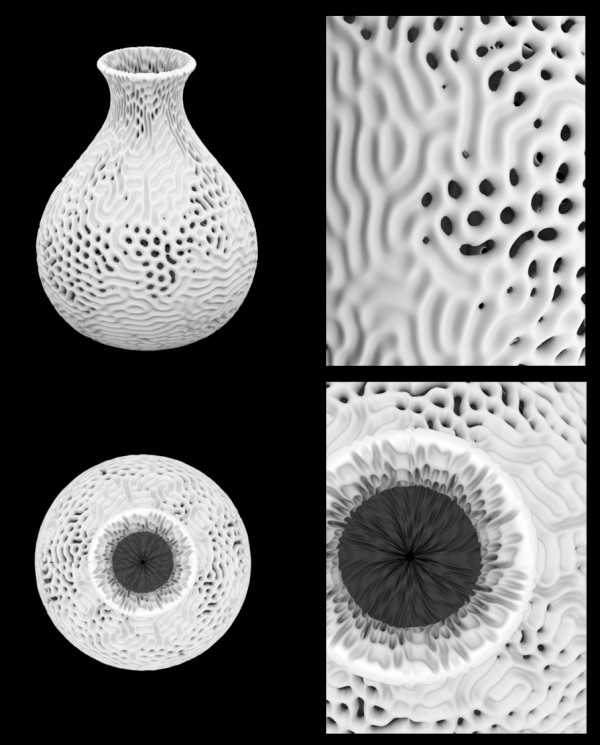Reaction Vase
I created this design yesterday for the Shapeways SIGGRAPH competition which asked designers to submit any design that costs less than $200 to 3dprint. Our submission is a sculptural vase generated by reaction diffusion, a process which simulates how chemicals diffusing across a surface react with one another to produce stable patterns.
made with Processing, rendered in Sunflow, polygons reduced to 500,000 for 3d printing with Meshlab. all free open source software!





3D printed reaction vase « Artificial Intelligence Church
[…] asked designers to submit any design that costs less than $200 to 3dprint. Our submission is a sculptural vase generated by reaction diffusion, a process which simulates how chemicals diffusing across a surface react with one another to […]
Scott Meyer
Its beautiful! Where can I buy one? And I know it costs less than $200, so no price gouging ;-)
Dan
I’m curious about an implementation detail concerning the application of reaction-diffusion equation solution to the vase. Did you apply it as a heightfield to a vase? And judging by the bottom, did you use the cylindrical coordinates of a point as its texture coordinate?
It’s really beautiful, and I hope to hear / see more about it at SIGGRAPH — good luck in the contest!
Reaction vase | Sophie Kahn
[…] in complex patterns generated by computation and nature.” The beautiful patterning on their Reaction Vase, above, was apparently generated by reaction diffusion, and it was made exclusively with […]
jessel
Dan,
It is essentially applied as a heightfield; however it is not one-to-one with the rd pattern. We used a blob detection algorithm to determine where areas of dots versus lines were and used that to transition from an embossed pattern to a cut out pattern (holes). The texture is applied with cylindrical coordinates. We experimented with methods that have less distortion/having a pattern that distorts to conform to the shape, but we decided that we preferred the distorted effect.
I am working on a method of growing the reaction diffusion pattern on a surface, which would allow us to play with high genus surfaces.
jessica
re: Scott Meyer
we may offer them for sale on shapeways and our website after we have had a chance to examine a printed copy
Dan
Jessel,
High genus surfaces would be awesome! I mean, you’re practically obligated to run it on the Stanford bunny, but there are plenty of beautiful shapes that would be fantastic.
Cynthia
I considered how much I wanted this vase until I realized that I couldn’t use it for actually holding flowers.
jessica
re: Cynthia
when / if we offer it for sale a larger percentage of the vase will be closed so it can hold water.
LM
Who cares if it holds water? That vase!
Bruno Demasi
http://www.giancarloscapin.com/parallelepipeda_in_dissolvenza.html